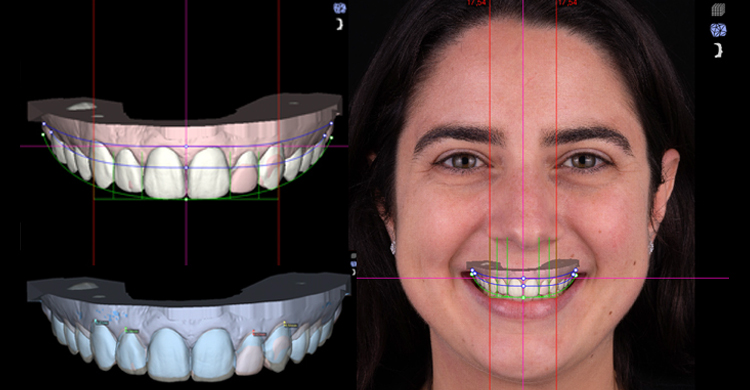
Blog Posts
RECENT BLOG POST


04 Aug 2021


10 Aug 2021


10 Aug 2021


By Dr. Aastha Chandra

14 Sep 2023
FACTORS INFLUENCING SMILE DESIGNING:
Introduction
Smile designing, a subset of Cosmetic Dentistry, is an art and science that aims to enhance a person’s smile through various dental procedures. It’s a comprehensive process that considers not only dental health but also the aesthetics of an individual’s smile. When embarking on a smile designing journey,
it’s crucial to understand the intricate interplay of physical factors that influence the outcome. In this article, we delve into the key physical factors that play a pivotal role in the art of smile designing.
1. Facial Structure and Symmetry:
One of the fundamental considerations in smile designing is the patient’s facial structure. The proportions of their face, the alignment of their eyes, nose, and lips, and the overall symmetry greatly influence how a smile appears. A skilled dentist takes these factors into account when recommending procedures such as Veneers. The goal is to create a harmonious smile that complements the individual’s facial features.
2. Lip Line and Smile Arc:
The lip line and smile arc are crucial components in smile aesthetics. The lip line refers to how much of the teeth are visible when a person smiles naturally. A balanced smile arc follows the curvature of the lower lip, resulting in a more pleasing appearance. Dentists carefully analyse these factors to determine the appropriate length and shape of teeth to achieve an aesthetically pleasing smile.
3. Tooth Shape and Size:
The shape and size of teeth play a significant role in smile design. Different tooth shapes evoke distinct impressions. For example, rounder teeth may appear more youthful, while more square teeth might convey a mature aesthetic. Similarly, tooth size relative to the patient’s facial proportions is essential. Oversized or undersized teeth can disrupt the overall harmony of the smile.
4. Tooth Colour and Shade:
Tooth colour is a vital aspect of Smile Designing. The shade of teeth should complement the patient’s complexion and personal preferences. Factors like age and lifestyle can influence the natural colour of teeth, and cosmetic dentists employ their expertise to achieve a natural yet enhanced tooth colour. Teeth whitening, veneers, and cosmetic crowns are some of the techniques used to achieve the desired shade.
5. Gum Line and Gingival Health:
The health and appearance of the gums have a significant impact on smile aesthetics. An uneven gum line or excessive gum display (known as a “gummy smile”) can detract from an otherwise beautiful smile. Gum contouring procedures can be employed to reshape the gums and create a balanced frame for the teeth. Maintaining optimal gingival health is crucial for the overall success of smile designing.
6. Tooth Alignment and Occlusion:
Misaligned teeth not only affect the appearance of the smile but also impact oral health. Improper alignment can lead to issues such as bruxism, difficulty in cleaning, and uneven wear of teeth. Orthodontic treatments, like braces or clear aligners, are often recommended to achieve proper alignment. Moreover, the way teeth come together when the jaws close (occlusion) must be carefully considered to prevent issues like jaw pain and premature wear of teeth.
7. Facial Movement and Dynamics:
A beautiful smile isn’t just about static appearance — It’s also about how it changes during facial expressions and movements. A well-designed smile should retain its aesthetics and balance even when the individual speaks or laughs. Cosmetic dentists take this dynamic aspect into consideration to ensure that the enhancements they make align seamlessly with the patient’s natural facial
dynamics.
8. Age:
The age of a patient is a key consideration in smile designing. Younger patients often seek a vibrant and youthful appearance, with a focus on bright, naturally aligned teeth. Orthodontic treatments like braces or clear aligners are commonly recommended to correct misalignments or crowding issues. Additionally, teeth whitening and minimal invasive procedures like dental bonding can help restore the youthful glow of teeth.
On the other hand, older patients might require a different approach. With age, teeth can wear down, lose their lustre, and develop cracks or chips. For such individuals, smile designing may involve treatments like veneers to restore both aesthetics and functionality. Addressing gum recession and the effects of aging on the supporting structures of the teeth may also become important considerations.
9. Patient’s Sex:
The facial features and smile characteristics that are considered attractive can vary between males and females. For instance, studies have shown that women often prefer slightly rounded tooth shapes, while men lean towards squarer shapes. Dentists take these preferences into account when selecting tooth shapes and sizes.
Furthermore, facial proportions differ between the sexes. A feminine smile tends to have more rounded, delicate features, while a masculine smile can be characterized by stronger, squarer shapes. Dentists work to enhance these inherent characteristics, creating smiles that align with the patient’s gender identity.
Conclusion:
Smile designing is a multidimensional process that requires a deep understanding of the physical factors that influence the appearance of a smile. Dentists who specialize in cosmetic procedures navigate the intricate interplay of facial structure, tooth characteristics, and other elements to craft smiles that are not only visually appealing but also harmonious with the individual’s unique features.
By addressing factors such as tooth shape, size, colour, alignment, and facial dynamics, these professionals create smiles that instil confidence and radiate natural beauty. So, whether you’re considering a minor enhancement or a complete smile makeover, rest assured that modern smile designing takes into account the nuanced physical factors that shape your perfect smile.

